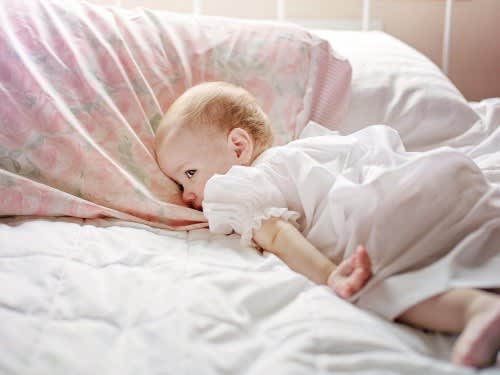What is Torticollis & How Can Osteopathy Help?

posted 22nd April 2025
What is Torticollis?
Sometimes called “wry neck”, Torticollis simply means a twisting or tilting of the neck. In babies, this often presents as an apparent preference to look in one direction over the other.
What causes Torticollis?
The most common form of Torticollis is a Congenital Muscular Torticollis, often caused by a shortening or tightness of the Sternocleidomastoid muscle in the neck. This can occur for various reasons:
- Positioning in Utero – especially if space was limited resulting in restricted movement. This is common with small mothers and larger babies, twins, or breech presentations
- Birth trauma or assisted deliveries including the use of forceps or ventouse
- Long and difficult labours with slow progression or baby becoming stuck
What are the signs?
Baby rotates the head to one side, or seems to look in one direction
Baby’s head tilts to one side
Baby prefers to feed on one breast, or laying on one side
A progressive flattening on one side of the head – this is known as a positional plagiocephaly
Discomfort when doing tummy time
If you notice any of the signs above, it may be worth getting your baby assessed. Early assessment and intervention can have the best results in reducing muscular tension and positional preferences. If left untreated, torticollis has the potential to affect your baby’s ability to roll, sit, and develop symmetrical movement patterns later.
How can Osteopathy help?
Paediatric Osteopathy uses a gentle, hands-on approach focusing on facilitating movement, reducing muscular tensions, and encouraging balanced development. Treatment is always tailored to the specific needs of each baby but may include:
- Gentle manual therapy – soft and gentle hands on approach to release muscular tension through the neck, back, and shoulders to increase range of movement
- Cranial osteopathy – A more subtle approach focusing on the head and upper neck. This can be used to address strain patterns from positioning in utero or birth trauma. This can be especially useful for those who have had long or difficult labour and deliveries, or assisted deliveries such as Caesarean sections
Overall nervous system regulations by reducing overall tension or discomfort within the body
Parental guidance – Advice on holding, feeding, positioning, and play with your baby to best aid their development. This may involve exercises, tummy time, and at home stretches to further ensure your baby’s comfort
Final thoughts
Every baby is unique, and as osteopaths we are here to help support your baby’s comfort, mobility, and development. If you have any concerns about your baby’s head position or flattening of the head, and you think there may be a Torticollis, we are always happy to help by providing a thorough assessment and examination to ensure appropriate treatment to suit your baby’s needs.
To make an appointment for your baby just go to osteopathywestlondon.com